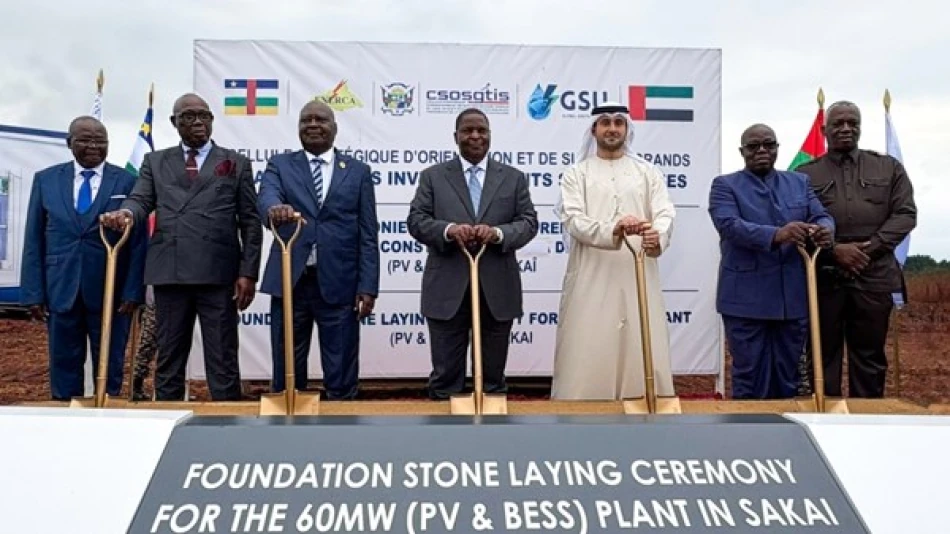
Emirati Firm Builds Solar Power Plant in Central Africa, Boosting Renewable Energy Access
UAE-Backed Solar Plant Breaks Ground in Central African Republic, Targeting 300,000 Homes
Global South Utilities, an Abu Dhabi-based investment arm, has launched construction of a 50-megawatt solar power facility in Sakai, Central African Republic, marking a significant step in the UAE's expanding clean energy footprint across Africa. The project promises to electrify over 300,000 homes while cutting carbon emissions by 50,000 tons annually, highlighting how Gulf capital is increasingly targeting underserved energy markets in sub-Saharan Africa.
Strategic Timing Following UAE-CAR Economic Partnership
The solar plant's groundbreaking comes just months after the UAE and Central African Republic signed a comprehensive economic partnership agreement in March 2025. This timing suggests coordinated diplomatic and commercial efforts, with energy infrastructure serving as a cornerstone of deeper bilateral ties.
President Faustin-Archange Touadéra attended the launch ceremony alongside Pascal Bida Koyagbele, Minister of State for Strategic Investments and Major Projects, underscoring the project's political significance for a country where reliable electricity remains scarce.
Technical Specifications Signal Grid Stability Focus
Beyond raw generation capacity, the facility includes a 10-megawatt-hour battery storage system designed to stabilize the national grid—a critical feature in countries with fragmented electrical infrastructure. This hybrid approach reflects lessons learned from similar UAE-backed projects in emerging markets, where intermittent renewable power can destabilize already weak grids without adequate storage buffers.
Local Employment and Knowledge Transfer
The project emphasizes local workforce development and technical knowledge transfer, addressing a common criticism of foreign-led infrastructure projects that rely heavily on imported labor. This approach aligns with broader trends in development finance, where sustainable impact increasingly depends on building local capacity rather than creating dependency relationships.
Market Implications for African Energy Investment
For investors watching African energy markets, this project represents several important trends. First, Gulf sovereign wealth and private capital continues flowing toward sub-Saharan renewable projects, competing with Chinese Belt and Road initiatives that have dominated infrastructure financing in recent years.
Second, the 50-megawatt scale suggests commercially viable projects don't require massive gigawatt installations to achieve meaningful impact in markets with low baseline electricity access. This "right-sizing" approach could accelerate deployment timelines compared to mega-projects that often face lengthy approval processes.
UAE's Broader African Energy Strategy
Global South Utilities positions this facility as part of a growing clean energy portfolio across Africa, reflecting the UAE's systematic approach to renewable energy investment beyond its borders. Unlike ad-hoc project development, this suggests a coordinated strategy to establish long-term energy sector presence across multiple African markets.
The timing also capitalizes on increased climate financing flows following COP28 in Dubai, where African energy access featured prominently in global climate discussions. UAE entities appear well-positioned to channel both commercial investment and climate finance toward projects that deliver measurable development outcomes.
Competitive Landscape and Regional Impact
This investment places the UAE in direct competition with other Gulf states and international players seeking African energy market share. Saudi Arabia's Vision 2030 includes similar outbound investment targets, while European development banks and Chinese state enterprises maintain significant African energy portfolios.
For Central African Republic specifically, the project could catalyze additional foreign investment by demonstrating that complex infrastructure projects can succeed despite challenging operating conditions. Success here may encourage other international developers to consider similar markets previously deemed too risky for large-scale renewable deployment.
Most Viewed News

 Layla Al Mansoori
Layla Al Mansoori






